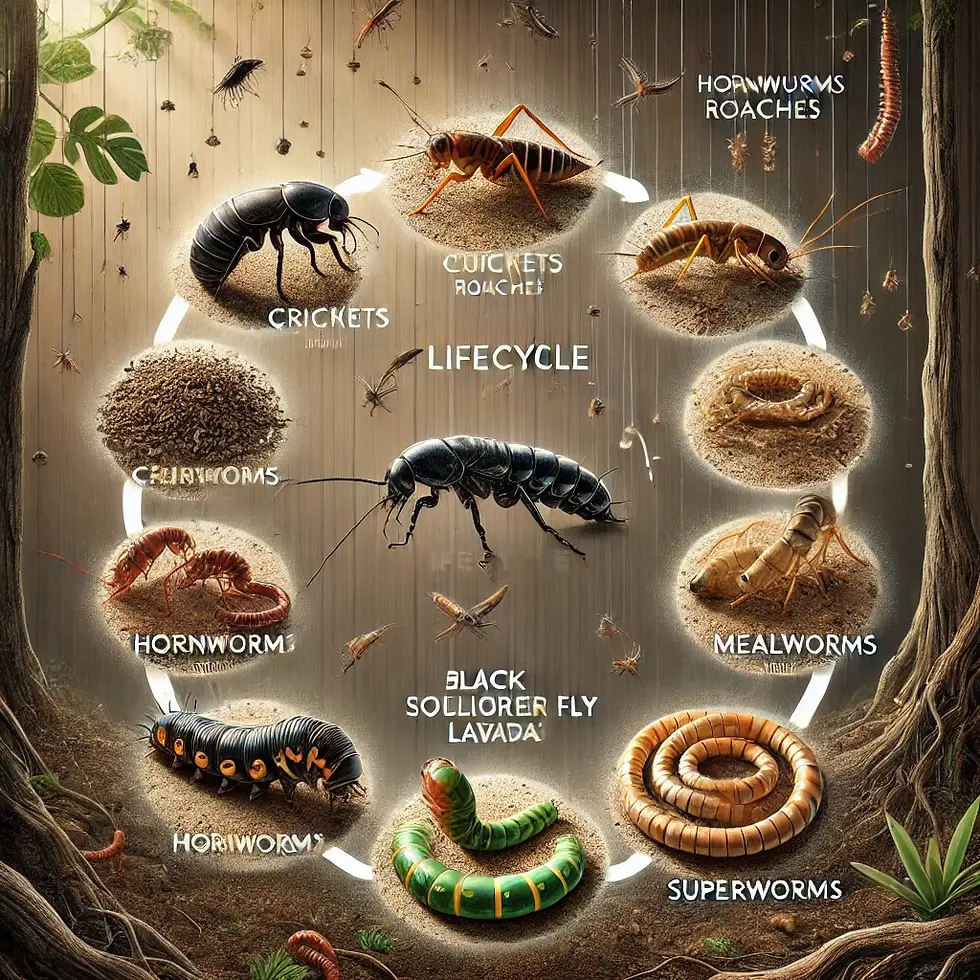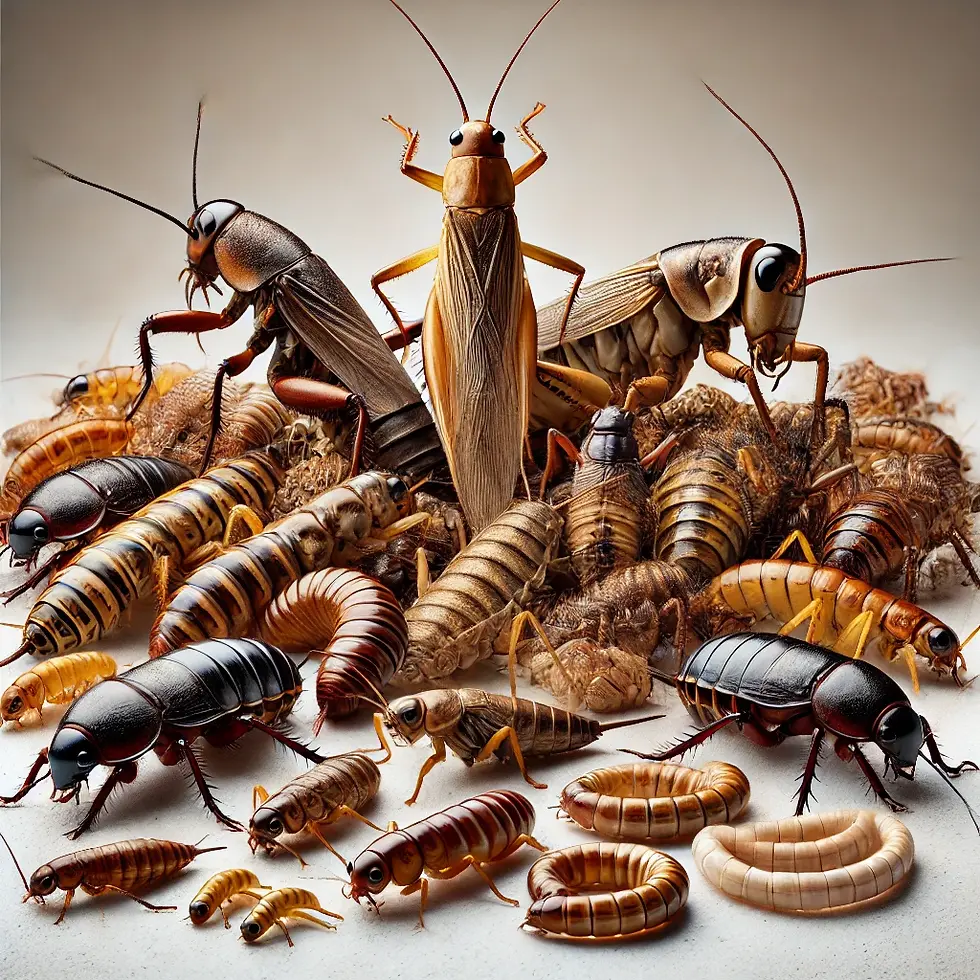The Lifecycle of Common Feeder Insects
- Rigor Moe

- Jan 16
- 3 min read
Updated: Feb 19
Understanding the lifecycle of feeder insects is essential for reptile enthusiasts and hobbyists looking to provide optimal nutrition for their pets. Knowing how these insects grow, reproduce, and age can help you manage their availability and nutritional value effectively. This guide explores the lifecycles of some of the most popular feeder insects.

1. Crickets (Acheta domesticus)
Crickets are a staple feeder insect, known for their high protein content and active movement.
Lifecycle:
Egg Stage: Female crickets lay eggs in moist substrate. The eggs hatch in about 7-10 days.
Nymph Stage: Nymphs resemble smaller versions of adults without wings. This stage lasts 4-6 weeks.
Adult Stage: Adults live for 2-3 weeks and are the most commonly fed stage.
Tips for Managing:
Provide a warm environment (75-85°F) to encourage rapid growth.
Feed crickets a nutritious diet to ensure they pass on nutrients to your reptile.
2. Dubia Roaches (Blaptica dubia)
Dubia roaches are a highly nutritious and low-maintenance feeder option.
Lifecycle:
Eggs and Nymphs: Female roaches give live birth to nymphs (no egg-laying stage). Nymphs grow over 3-6 months, molting several times.
Adult Stage: Adults can live up to two years and continue reproducing throughout their lifespan.
Tips for Managing:
Keep them at 80-90°F with moderate humidity (50-60%).
Provide fruits, vegetables, and protein-rich foods to maintain their nutritional quality.
3. Hornworms (Manduca sexta)
Hornworms are soft-bodied and high in moisture, making them ideal for hydration.
Lifecycle:
Egg Stage: Eggs hatch in 3-5 days.
Larval Stage: Larvae (hornworms) grow rapidly and can reach full size (3-4 inches) in 2-3 weeks.
Pupal Stage: Larvae burrow to pupate, emerging as hawk moths in 1-3 weeks.
Tips for Managing:
Store at cooler temperatures (50-55°F) to slow growth.
Use hornworms as occasional treats due to their high water content.
4. Mealworms (Tenebrio molitor)
Mealworms are widely available but should be fed sparingly due to their high fat content.
Lifecycle:
Egg Stage: Eggs hatch in about 4-19 days.
Larval Stage: Mealworms remain in this stage for 10 weeks, growing steadily.
Pupal Stage: Pupae take 1-3 weeks to develop into adults.
Adult Stage: Adult beetles live for 4-8 weeks and reproduce prolifically.
Tips for Managing:
Store mealworms in a refrigerator to slow their development.
Gut-load them before feeding to maximize nutritional value.
5. Black Soldier Fly Larvae (BSFL)
BSFL are small, nutrient-rich larvae that are rich in calcium.
Lifecycle:
Egg Stage: Eggs hatch in about 4 days.
Larval Stage: Larvae grow for 2-3 weeks before pupating.
Pupal Stage: Pupae transform into adult flies within 1-2 weeks.
Adult Stage: Adults live for 5-8 days and do not eat during this time.
Tips for Managing:
Keep larvae at room temperature to maintain their growth.
No gut-loading is required due to their natural calcium content.
6. Superworms (Zophobas morio)
Superworms are larger and fattier than mealworms, making them ideal for occasional feeding.
Lifecycle:
Egg Stage: Eggs are laid by beetles and hatch in about 10 days.
Larval Stage: Larvae grow for 8-12 weeks, molting multiple times.
Pupal Stage: Pupation occurs over 1-2 weeks.
Adult Stage: Adult beetles live for 2-3 months and reproduce consistently.
Tips for Managing:
Avoid refrigerating superworms, as cold temperatures can kill them.
Provide high-protein foods to gut-load them effectively.
Final Thoughts
Understanding the lifecycle of feeder insects allows you to plan ahead and optimize their use for your reptiles. Each insect offers unique nutritional benefits, and managing them properly ensures your pet gets the best diet possible.
Have a favorite feeder insect or management tip? Share it in the comments below!
For more on reptile care and feeding, check out:
"Top Feeder Insects for Bearded Dragons"
"Hydration Tips for Reptiles"






Comments